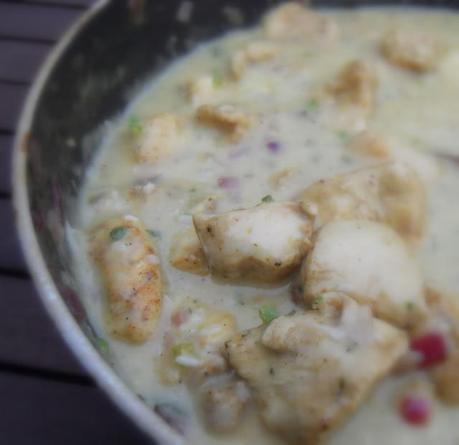
One of the things I have learned to embrace over here in the UK, and which I had very little experience with prior to moving over here was curries. I think my sum experience of eating curry had been when, living on a British Army training base in Canada back in the early 1980's, a British friend of ours cooked us a curry. I really enjoyed it, but I couldn't tell you now or then if it was authentic or not.
"Curries with their vast partioned platters of curious condiments to lackey them, speak for themselves. They sting like serpents, stimulate like strychnine, they are subtle, sensual like Chinese courtesans, sublime and sacred, inscrutably inspiring and intelligently illuminating like Cambodian carvings."
~Alistair Crowley (1875-1947)
Few things are as simple, or as complex, as curry. The word itself is both a noun and a verb, referring not only to dishes prepared with curry powders but also to an international style of cooking. It's pretty much identified with Indian cuisine, but is also found in countries like Jamaica, Portugal, Indonesia and Ethiopia, with each area interpreting it ti suit local tastes and ingredients. For instance, a Caribbean curry would traditionally be dry, but sweet, often mixed with bananas and mangos and flavoured with nutmeg, sugar and rum. In Laos, Thailand and Burma, curries are often hot and simmerd with coconut milk. In the south of India they tend to be hot, whilst in the north they tend to be drier and milder. One thing is for sure however and that is they are universally enjoyed by most people and in fact, curry is amongst the top two or three favorite dishes considered to be national dishes here in the UK.
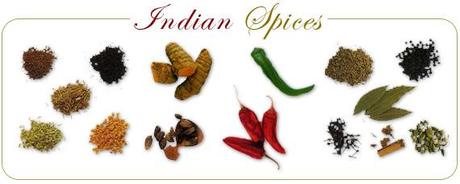
What is Curry Powder?
Just a pinch transforms a dish and yet curry powder is not a single spice, but a blend of aromatic spices, usually including coriander, cumin, ginger, cloves, cafdamom, fennel, fenu-greek, tumeric and heat adding fresh or dried red or green chilies, cayenne pepper, ground peppercorns or mustard seeds. Southeat Asian curry powders may include lemon grass, coriander root and shrimp paste.
Sweet curry powders made with cardamom, nutmeg, cloves and cinnamon and which usually include some form of pepper, are as authentic as fiery ones. They are traditional iin the port towns of south-western India and are wonderful in flavouring chicken, fish, pasta salads and soups.
Classic Indian cooks hold that each kind of meat and vegetable should be flavoured with it's own blend of spices, tailored to the dish and specially prepared according to taste or tradition. They will argu endlessly about the optimum mixture of spices and the inclusion or exclusion of a certain ingredient.
Indian cooks, both at home and abroad, are pretty much like the rest of us, likely to take advantage of ready ground spice mixes, as well as prepared pastes, oils and sauces. Purists might shake their heads, but there are some excellent commercially prepared curry powders of all sorts and strengths which are widely available today. Minimally, curry mixture usually include three core spice ingredients: Coriander, tumeric and chilies or pepper.
Three standard intensities are generally available . . . mild, medium and hot, depending on the amount of chilies included in the mixture. Heating, roasting, and browning curry powder intensifies it's flavor and color and is usually an important part of curry making.
Be aware however that like most spices, curry powders can go stale and lose their flavor during storage, especially at room temperature, so do make sure you only buy small amounts at a time and discard it when it's less than vividly aromatic, normally after two or three months.
Garam Masala (meaning "hot spices") is a powdered blend of basic Indian spices that can be used instead of ready ground curry powder. It usually contains cumin, cardamom, coriander, peppercorns, cloves, cinnamon and nutmeg.
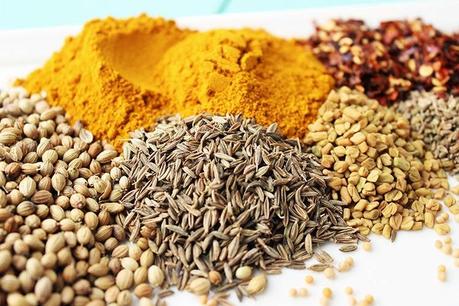
*Quick Curry Powder*
Makes about 1 cupPrintable Recipe
This hot curry powder can be used for a meat, fish or vegetable dish. If you can't find one of the ingredients, leave it out. If you are particularly fond of one, add more of it. The heat comes from the mustard, black pepper and cyenne, so do use them judiciously. (I am a curry wimp so I prefer less rather than more.) Store in a small jar, tightly closed and use as soon as possible.
2 TBS coriander seeds2 TBS cumin seeds1 TBS mustard seeds1 TBS black peppercorns1 TBS fennel seeds1 TBS whole cloves1 TBS ground tumeric1 TBS ground cardamom2 tsp ground cinnamon2 TBS freshly ground cayenne
Roast the whole spices in a small, heavy skillet, stirring constantly or in a low oven for about 15 minutes, until they become quite fragrant Stir in any ground spices and then grind them all together in a spice grinder or with a good mortar and pestle.

This is a fabulous curry. It's quick, easy and full of lovely flavours. It's not much to look at . . . I'll agree, but . . . this is definitely a case where you shouldn't judge the book by it's colours. You get a bit of heat from the green chillies, and some chili powder . . . and of course the curry powder. I don't like mine really hot so I use a medium strength curry powder.

The lime juice and zest gives a bit of a tang, and of course the coconut milk gives a special richness.
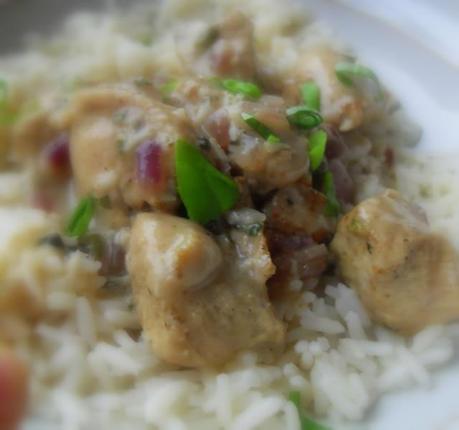
The basil is quite simply surprisingly lovely. Don't stint on any of the seasonings and once it's cooked, taste it and adjust it according to your own tastes. You may find that you want a bit more ginger, or curry, or even chili. I do think you'll like it. It's simple with subtle flavours, which when combined make it entirely delicious, if I don't say so myself!
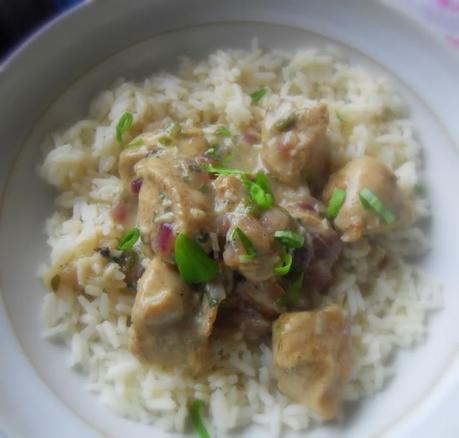
*Coconut Basil Curried Chicken*
Serves 4
Printable Recipe
You can charge up the heat of this by using a hotter curry powder. I don't like too much heat, so I use medium. Delicious!
3 skinless boneless chicken breast halves
2 tsp curry powder
1 tsp fine sea salt, divided
1/2 tsp black pepper
1/4 tsp chili powder
5 cloves garlic, peeled and minced
2 tsp freshly grated gingerroot
1 medium red onion, peeled and finely chopped
2 green chilies, seeded and finely chopped
1 TBS olive oil
the juice and finely grated zest of one lime
1 (410g) tin of coconut milk (I use the light, 14 ounce tin)
1 TBS cornflour (cornstarch)
1 TBS freeze dried Basil leaves
To serve:
hot steamed basamati rice
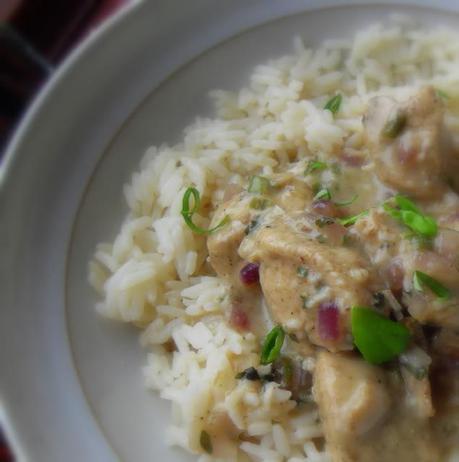
Cut the chicken into 1 inch pieces. Place into a bowl. Stir together the curry powder, 1/2 tsp of the salt, the black pepper and the chili powder. Add this mixture to the chicken chunks and mix well together with your hands, making sure all the chicken is well coated. Cover and chill for several hours.
When you are ready to cook the curry, heat a large nonstick frying pan over medium heat. Add the olive oil. Once it is hot add the onion, basil, garlic, green chilies, and gingerroot. Cook and stir for 3 to 4 minutes, until the onion is translucent. Add the chicken pieces and the remaining 1/2 tsp of salt. Cook, stirring occasionaly for 5 to 6 minutes, until the chicken is cooked through. Combine the coconut milk. lime juice and zest and cornflour. Add to the skillet carefully, whisking vigorously. Cook and stir until slightly thickened and bubbling away. Taste and adjust seasoning as required. You may want more chili, ginger or curry powder. (It's a matter of taste.) Serve hot over steamed basamati rice.
Note: If you happen to have some fresh basil in the house, tear up a few leaves and toss them on top for a pretty garnish!

